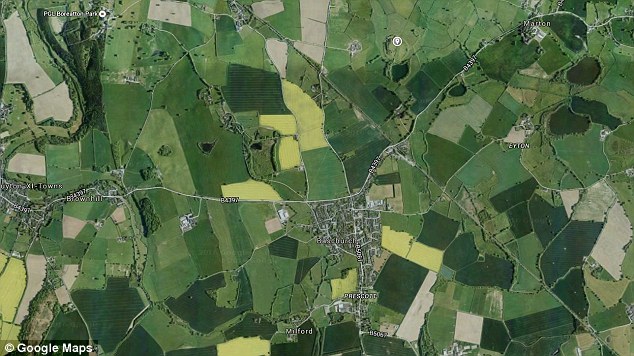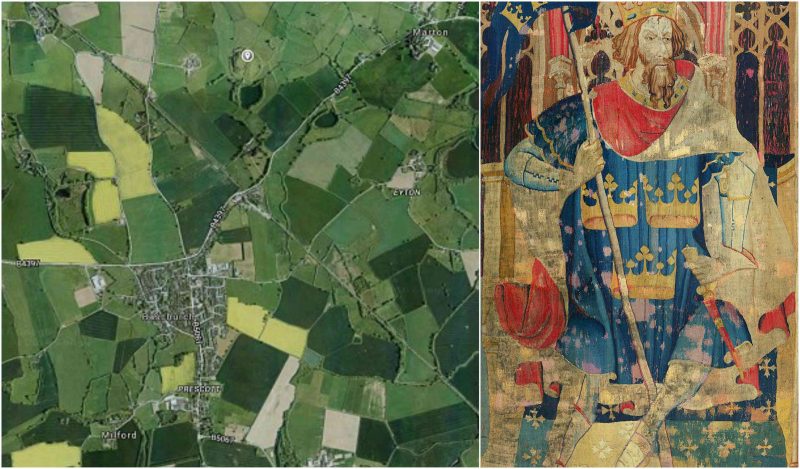Many readers will be familiar with the stories of King Arthur, who wielded his mystic sword Excalibur. The king was the leader of the defense against the Saxon defense and is thought to have been born at Tintagel Castle in Cornwall. After he was injured during a battle with his enemy Mordred, King Arthur was taken to the Isle of Avalon. Then, King Arthur just disappeared. Reason suggests that the king had died and was buried on the island. Recent evidence suggests, however, that King Arthur was buried in what would become a mere field in Shropshire.
The evidence comes from Graham Philips, who describes himself as a historical detective. He has been researching the life of the British king for years and has written a book, called The Lost Tomb of the King, that explains his theory. The theory basically claims that there is evidence that suggests the medieval leader was buried outside the village of Baschurch.

Originally from Stafford, Philips has claimed that there are two likely locations of the tomb. The first possibility is an earthwork that is located just outside the village—it is believed to have been an old fort and is called the Berth. The other possibility is the site of a former chapel.
This is not the first research that Mr. Philips has done regarding King Arthur. His previous work was to verify whether King Arthur lived at the Roman fortress at Wroxeter. According to Philips, “From my research, he [King Arthur] came from Shropshire, not the southwest of England as everybody else says.” He explained. “In the Oxford University Library there is a poem from the Dark Ages which refers to the kings from Wroxeter who were buried at the Churches of Bassa—and when you think about anywhere in Shropshire that sounds similar, you think of Baschurch. There is a place that matches the description just outside the village, an earthworks known as The Berth, which were two islands in a lake, though obviously the lake has now gone.”
He continued to say that although no excavations have taken place yet, some outline work has found a pit in the Berth that contains a large piece of metal. This is, he believes, King Arthur, buried with his shield. It is the same manner in which other monarchs were buried at the time.
As to his progress in getting permission to dig, he said. “At the moment I’m trying to get permission from English Heritage for an archaeological dig, but they don’t often give that because they want to protect the site. With technology moving forward, in the not-so-distant future we may be able to see what is in there without digging. But I believe it is absolutely necessary because otherwise other people might go there and destroy the site.”
The other site that had caught his attention was a former chapel. Now, it is a country lane called Birch Grove that is in the village. Evidence for this chapel was found back in the 1930s.
“In some versions of the tale of King Arthur he died on an island, but was brought back to shore for burial.” Philips explained. “So it is possible and when they found the remains, they found part of a gravestone with Latin writing that appears to translate to ‘Here Lies.’ It would be easier to get permission to dig there because it is not protected, so that could take place very soon.”
King Arthur is a controversial figure. There is still debate on whether King Arthur was a real person, a character based on a real king, or a completely fictionalized figure. Both the Historia Brittonum (History of the Britons) and Annales Cambriae (Welsh Annals) state that Arthur was a genuine historical figure, a Romano-British leader who fought against the invading Anglo-Saxons in the late 5th to early 6th century. The Historia Brittonum from the 9th century lists twelve battles that King Arthur fought. One such battle was the Battle of Mons Badonicus, where he is said to have killed 960 men. The reliability of these texts, however, have been doubted by some scholars. On top of that, Arthur is not mentioned in any documents that were written between 400 and 820, such as the Anglo-Saxon Chronical or Bede’s Ecclesiastical History of the English People.
![Arthur as one of the Nine Worthies, wearing a coat of arms often attributed to him[1] (c. 1385) Source](https://www.thevintagenews.com/wp-content/uploads/sites/65/2016/07/Arthur-as-one-of-the-Nine-Worthies-wearing-a-coat-of-arms-often-attributed-to-him1-c.%E2%80%891385-365x640.jpg)
Chester, called the City of the Legion during the Dark Ages, was the site of one of Arthur’s most celebrated battles against the Saxons. Evidence of a battle was found by archeologists nearby at Heronbridge. Furthermore, excavations have found a fortified amphitheater with a shrine to a Christian martyr at its center. This echoes the description of Arthur’s Round Table that is said to have been large enough to seat 1,600 warriors.
Back in the 1960s, Philip Rahtz led excavations that discovered that the top of Glastonbury Tor was inhabited by someone during the Arthurian period. This could have been King Melaus, who abducted Queen Guinevere. He spirited her away to his castle at Glastonbury. Or, this person could have been Gwynn ap Nudd, one of Arthur’s warriors who was banished from his Palace on the Tor.
The discoveries go even further back. In 1191, monks at Glastonbury Abbey found the body of a gigantic man, who had sustained several head wounds. In the oak coffin were also the bones of his wife and a tress of her golden hair. Found with the human remains was an ancient lead cross, inscribed with “Here lies buried the famous King Arthur with Guinevere his second wife, in the Isle of Avalon.” What happened to the remains and the artifacts is unknown—they are lost to us. In 1962, however, archeologists did find evidence that supports this story of a tomb within the ancient church.
